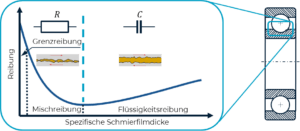Lubricant contamination accounts for approximately 25% of premature roller bearing failures [Tec00, p. 11]. Despite its relevance, detecting contamination is highly complex and often not feasible—especially in grease-lubricated systems. To avoid costly machine downtimes, manufacturers frequently resort to replacing bearings well before the end of their service life or changing the lubricant preventively. However, both approaches come with significant economic and ecological drawbacks, including resource consumption and increased energy usage during bearing production. Even with such preventive measures, unexpected contamination can still cause bearing failures, leading to production halts and additional expenses.
Common Types of Contaminants in Bearings
Contaminants often originate from the environment and can bypass the seal to enter the bearing. Additionally, abrasion within the machine or directly inside the bearing itself can produce contaminants. This is especially critical in oil-lubricated systems, where contaminants may circulate and affect multiple bearings.
The impact of solid particles depends largely on their size, hardness, and concentration. Particles harder than the bearing material severely reduce bearing lifespan, as they lead to surface pitting and chipping. Even softer particles pose a threat. They can interrupt the hydrodynamic lubricating film in the contact zone, accelerating wear. In some cases, they may adhere to the raceway, increasing surface pressure and causing further damage [Kou14].
Particles larger than the lubricant film thickness are ground down, while softer particles flatten out. Particularly concerning are particles whose diameter is comparable to the lubricant film thickness (~10⁻⁶ m). These disturb the formation of the lubricating film, causing lubricant deficiency [Dwy9].
It’s important to note that the speed of bearing damage increases proportionally with contaminant concentration. Moreover, most of the damage—measured in terms of abrasion—occurs within the first 10 hours following contamination [Cel77].

Water as a Common Contaminant
Another widespread issue in bearings is water contamination. Whether in liquid form or introduced via air humidity, water significantly compromises lubricant performance and is notoriously hard to detect.
Undissolved water subjected to high pressure in the rolling contact zone may split into atomic hydrogen and oxygen. This leads to hydrogen embrittlement of the bearing steel, increasing the risk of pitting. Simultaneously, the presence of oxygen accelerates lubricant ageing due to oxidation [Car10, p. 2].
Detecting water contamination is even more challenging than identifying particles. Traditional vibration monitoring systems only register bearing damage after it has occurred, without clarifying the root cause. Although circulating oil systems allow water content detection using H₂O spectroscopy, this method requires additional resources and lacks real-time monitoring capabilities [Lei18].
How HCP Sense Technology Detects Lubricant Contamination in Bearings
Is there a more efficient way to identify contamination early? Yes, HCP Sense sensor technology offers a unique solution.
This technology leverages the electrical behavior of bearings when an AC voltage is applied. By measuring impedance, conclusions about the lubricating film thickness can be drawn based on the electrical resistance and capacitance. The working principle is similar to that of a plate capacitor:

In this context, capacitance depends primarily on the rolling contact experiencing the highest load. When rolling elements flatten (increasing surface area A) and the lubricant film thickness decreases (distance d), the capacitance C rises.
The key advantage is that this measurement provides real-time insights into the lubrication condition exactly where damage would occur. Thanks to high sampling rates, even minute changes during rotation can be analyzed.
How Lubricant Particles Affect Electrical Measurements
When a particle enters the contact zone, it interrupts the lubricating film. This disruption results in a measurable increase in capacitance and a simultaneous drop in resistance. In raw measurement data, such events appear randomly and can be clearly distinguished from pre-existing surface damage or irregularities.
Moreover, the sensor system differentiates between various contaminants—such as mineral particles (like sand) and metallic contaminants—based on their unique electrical properties.

By identifying individual particles and monitoring their concentration, the system allows you to take targeted action. For example, small quantities of soft materials may not necessitate immediate lubricant or bearing replacement. Instead, corrective measures can be taken early to stop further contamination and identify its source. This proactive approach prevents costly damage and optimizes maintenance intervals.
Benefits of HCP Sense Technology for Lubricant Contamination Detection
- Prevention of damage due to lubricant contamination
- Identification of the smallest amounts of contamination down to individual particles
- Gaining knowledge about the source of contamination as a basis for root cause analysis instead of symptom treatment
- Recommendations for countermeasures and lubricant changes, tailored to the needs of your specific use case
- Support with experience and expertise gained from research and industry
References
[Car10] Carlos Goncalves und L.R. Padovese. „Vibration and oil analysis for monitoring problems related to water contamination in rolling“. In: International Brazilian Conference on Tribology (2010).
[Cel77] B. CeleFitzsimmons und H. D. Clevenger. „Contaminated Lubricants and Tapered Roller Bearing Wear“. In: A S L E Transactions 20.2 (1977), S. 97–107.
[Dwy99] R.S Dwyer-Joyce et al. Surface damage effects caused by debris in rolling bearing lubricants, with an emphasis on friable materials. 1999.
[Kou14] D. Koulocheris et al. „Experimental study of the impact of grease particle contaminants on wear and fatigue life of ball bearings“. In: Engineering Failure Analysis 39 (2014), S. 164–180.
[Lei18] Dirk Leimann, Gerhard Gajewski und Dirk Arnold. „Wassergehalt in Ölen: Einfluss unterschiedlicher Wassergehalte in Ölen auf die Ermüdungslebensdauer von Wälzlagern und die Grübchentragfähigkeit einsatzgehärteter Stirnräder“. In: FVA 1299 (2018).
[Tec00] Schaeffler Technologies. Wälzlagerschäden, Schadenserkennung und Begutachtung gelaufener Wälzlager. 2000. url: https://www.schaeffler.com/remotemedien/media/_sharedmedia/ 08_media_library/01_publications/schaeffler_2/tpi/downloads_8/tpi_176_de_de.pdf (23. Juli 2023)



